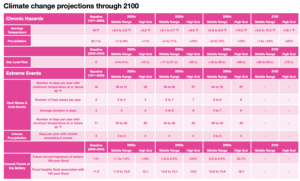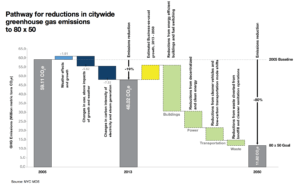Learning from Disaster: NYC After Hurricane Sandy

What can Hurricane Sandy teach us about sustainability and resiliency?
A coastal city at risk
With 520 miles of coastline and some of the most valuable real estate in the world, New York City is at significant risk from the rising sea levels and harsher storms caused by climate change.[1] On October 29, 2012, Hurricane Sandy, the worst natural disaster ever to hit the city, demonstrated the extent of that vulnerability. Forty-four people died in the storm, 51 square miles flooded, fires raged, power went out for days, and the city suffered an estimated $19 billion in damages.[2] While Sandy was unique, the risks it exposed are significant and growing. Rising sea levels and ocean temperatures mean that a similar storm would cause nearly five times the damage by the 2050s.[3]
The New York City Panel on Climate Change indicates that both chronic hazards and extreme events will become worse in the coming decades. By the 2050s, average temperatures could rise by 6.6º F, the sea level in the city could rise by over two feet, and the number of heat waves and days above 90º F could more than triple compared with 2000 levels.[4] Among other effects, these changes would mean an increase in coastal flooding—already a regular occurrence in some areas of the city—and during the hot days and heatwaves a much greater strain on the power supply from air conditioners and cooling systems, potentially leading to rolling brownouts and blackouts if not managed properly.
Lowering greenhouse gas emissions
Governments have a particular responsibility in slowing climate change, and though the most power lies with the federal government, New York City has a role to play. The city’s stated goal is to reduce greenhouse gas emissions by 80% by 2050, relative to 2005 levels. This “80 X 50” plan also has an interim goal of 40% reduction by 2030.[5]
The four main sources of greenhouse gas emissions are from transportation, buildings, waste, and power production. In most parts of the country, the lead producer is vehicle emissions, but in New York City the ratio is flipped, with buildings contributing the majority of emissions. In a city of approximately one million buildings, a number of strategies are necessary to make the significant reduction planned.[6] For buildings that the city itself controls, it is retrofitting significant energy users and installing renewable power. For privately owned buildings, the city is launching a Retrofit Accelerator to provide information, assistance, and incentives to small and medium-sized building owners, and using its regulatory power to require building energy benchmarking and audits.[7]
Adapting to the effects of climate change
Even as the city seeks to lessen its contribution to the problem, it must deal with the effects of climate change. For disasters like Sandy, this means being prepared to respond quickly, with all the advanced safety, communication, and emergency services of a modern city. But in a complex ecosystem like New York, the actions of one entity alone are not enough. The city must actively foster partnerships and support groups that can help it weather disasters.
Nonprofits like the Red Hook Initiative provide on-the-ground networks and responsiveness to community challenges that a bureaucracy cannot address as quickly. In the immediate aftermath of Sandy, Red Hook Initiative opened its doors to its neighbors in its low-lying coastal neighborhood in Brooklyn, offering supplies, meals, Wi-Fi, and legal and medical support.[8]
Large businesses also have a role to play—from working with their immediate communities and workers to managing the major infrastructure assets they control, from distribution fleets to telecommunications networks to backup generators.
To foster these actions, the city can provide support and funding to nonprofits, and actively build relationships with businesses. It also has some power as both a customer and regulator of major infrastructure providers—in particular telecommunications, transit, and healthcare companies—to ensure that they are prepared and actively coordinating for severe events.
What more can be done?
As the largest city in the United States—home to 8.5 million people—and a global beacon that welcomes over 56 million visitors each year, New York City has a major platform to influence the discussion on climate change worldwide.[9] [10] Mayor Michael Bloomberg (HBS, 1966) was an early leader when his administration released its first PlaNYC in 2007 as a blueprint to become “the first environmentally sustainable 21st century city.”[11] Mayor Bill de Blasio has continued that work, explicitly talking about the linkage between climate change and inequality, for example in a visit in 2015 to present the city’s plans at a Vatican summit.[12] The city has won awards and presented its sustainability work worldwide, but building a larger focus on using New York City’s experience to spread sustainability and resiliency best practices would have a positive impact both globally and locally.
Citations
[1] “PlaNYC: A Stronger, More Resilient New York,” City of New York, 2013, p. 40, [http://s-media.nyc.gov/agencies/sirr/SIRR_singles_Lo_res.pdf], accessed November 2016.
[2] Ibid., pp. 5, 13.
[3] Ibid., p. 5.
[4] “One New York: The Plan for a Strong and Just City,” City of New York, 2014, p. 216, [http://www.nyc.gov/html/onenyc/downloads/pdf/publications/OneNYC.pdf], accessed November 2016.
[5] Ibid., p. 166.
[6] NYC Deptartment of Buildings, [http://www1.nyc.gov/site/buildings/about/about.page], accessed November 2016.
[7] “One New York: The Plan for a Strong and Just City,” p. 174.
[8] Ibid., p. 223.
[9] “NYC Statistics,” NYC & Company, 2015, [http://www.nycandcompany.org/research/nyc-statistics-page], accessed November 2016.
[10] “New York City QuickFacts,” US Census, 2015, [http://www.census.gov/quickfacts/table/PST045215/3651000], accessed November 2016.
[11] Thomas J. Lueck, “Bloomberg Draws a Blueprint for a Greener City,” New York Times, April 23, 2007, [http://www.nytimes.com/2007/04/23/nyregion/23mayor.html], accessed November 2016.
[12] Stephanie Kirchgaessner, “Mayor Bill de Blasio pledges to cut New York carbon emissions by 40% by 2030,” The Guardian, July 21, 2015, [https://www.theguardian.com/us-news/2015/jul/21/mayor-bill-de-blasio-pledges-cut-new-york-carbon-emissions-2030], accessed November 2016.
Images
“Water Levels Around New York City on October 29, 2012” from “PlaNYC: A Stronger, More Resilient New York,” City of New York, 2013, p. 13, [http://s-media.nyc.gov/agencies/sirr/SIRR_singles_Lo_res.pdf], accessed November 2016.
“Climate Change Projections through 2100” from “One New York: The Plan for a Strong and Just City,” City of New York, 2014, p. 216, [http://www.nyc.gov/html/onenyc/downloads/pdf/publications/OneNYC.pdf], accessed November 2016.
“Pathway for Reductions in Citywide Greenhouse Gas Emissions to 80×50” from ibid., p. 167.
(789 words)





Peter,
Great post. You did a great job identifying the climate change issues affecting NYC. As a native New Yorker, this issue strikes close to home. Thanks for highlighting it.
A couple questions the post left me contemplating:
1) Do you think NYC will reach its stated goal by 2050? How has progress been over the last few years?
2) You mention that large businesses also have a role to play—curious what if anything consumers can do in NYC? Certainly a disperse set of constituents to influence, which could be challenging, but I imagine there’s something ordinary New Yorkers can do to help as well?
3) What are the main components of retrofitting a building that make it more energy efficient? Are the improvements entirely from installing renewable power? Or are they also from actions such as installing better heating and cooling systems?
Overall, nicely done, and thanks for bringing this issue to everyone’s attention!
Peter,
I liked reading your post and I could not agree more that NYC should set an example in the overall combat against climate change. That being said, New York should also prepare itself to withstand such storms. I see you mentioned a USD 19bn loss due to Sandy. Assuming that a similar future storm would also cause a USD 19bn loss, one could argue that we have to “borrow from the future” and invest today in shore protection. What is your view on what New York should do to protect itself?
Thanks for the interesting post. This is somewhat personal as I witnessed Hurricane Sandy in NYC first-hand, and living in an affected neighborhood I spent a week without electricity – on the 24th floor with an elevator that didn’t work, in an area without functioning traffic lights, all shops closed and barricaded, surrounded by broken trees and cars… reminded me of the movie “I am Legend”. While I was fortunate to have friends “in the North” – i.e. with functioning electricity – I understand that many people were horribly affected as Sandy wiped out their houses and destroyed their lives. I was shocked to read that a similar storm would cause nearly five times the damage by the 2050s.
On the positive side however, it was encouraging to see that the city has ambitious goals to cut emissions. I also really appreciated to see that NYC has actually managed to cut emissions by 19% from 2005-2013. I also found it interesting to learn that in NYC, very different sources cause greenhouse gas emissions than in the rest of the country – which requires a different plan of action than on the federal or state level. I strongly agree with your recommendation that on top of its own ambitious targets, NYC should be an ambassador to other cities and convince them to implement similar targets. NYC should make it “trendy” to follow its lead.
I also wonder what could be done to make citizens feel more responsible, and think more “green”. It is definitely possible, as, for example, many West Coast cities successfully encourage to recycle more, and many cities in Asia are extremely clean due to the complete lack of littering [1]. Is this a culture than can be taught?
[1] Why the Japanese Don’t Litter, A lesson in Courtesy and Respect. 2016. Why the Japanese Don’t Litter, A lesson in Courtesy and Respect. [ONLINE] Available at: http://japantravelcafe.com/japanese-culture-2/why-the-japanese-dont-litter. [Accessed 07 November 2016].
Really interesting post! One thing that surprised me during Sandy was the MTA’s inability to respond adequately to the crisis. I believe their losses resulting from equipment failures, station damages, etc. amounted to over $5 billion. The MTA commissioned an after-impact report post Sandy but I’m not aware of any concrete steps that have been taken in response to the threat of global warming. Obviously any infrastructural improvements to minimize the impact of storm surges would entail significant capital expenditures. How do you think the MTA should determine if and how much of an investment they should make to prepare and protect the city?
Peter,
Thank you so much for sharing on this interesting and unique topic! As someone who has called New York home for the past nine years, the threat of climate change on New York and other coastal cities around the world is terrifying to me. While I’m glad that New York is embracing its role as a global leader in the fight against climate change, I can’t help but be skeptical and wonder how much of this is PR and how much is impactful and actionable efforts that will yield real results. Has the NYC government set aside adequate funding to do this work? How will they directly engage nonprofits, corporations, and other parties, and more importantly, how will they hold everyone accountable to the part that they will play in this fight?